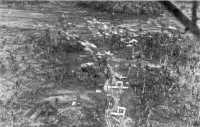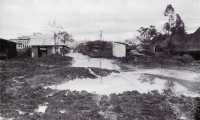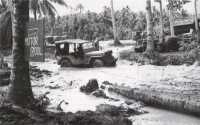Chapter 18: Logistics
The conquest of Leyte was taking longer than had been anticipated. The decision of the Japanese to make Leyte the decisive battleground of the Philippines had forced the Americans to commit not only the reserve 32nd and 77th Infantry Divisions but also the 112th Cavalry Regimental Combat Team, the 11th Airborne Division, and elements of the 38th Infantry Division. The inability of the Americans to establish considerable land-based air forces on Leyte, as well as the unexpected Japanese reinforcement program, had retarded the campaign. Not only was the timetable of future operations in the Pacific upset, but a strong possibility existed that it would not be feasible to establish a major logistical and air base on the island – the primary purpose of the operation.
The construction program on Leyte was hampered by conflicting priorities and, as had been foreseen, very poor terrain, bad weather conditions, and a shortage of service personnel.
Construction
Retelling the disagreements and describing the conflicts that arose over the ever-changing needs of the Army, Navy, and Air Forces would be involved, tedious, and unprofitable. But the progress of the construction program must be recounted, since it had direct bearing not only on the Leyte Campaign but also on the Mindoro and Luzon operations.
Airfields
The importance of the development of the airfields cannot be overemphasized. The inability of the Sixth Army to meet its construction dates on the airstrips, because of poor soil conditions and heavy rains, prevented the U.S. forces from stopping the flow of Japanese reinforcements and made it impossible for the Allied Air Forces to give sufficient land-based air support to the ground troops. It also forced a postponement of the Mindoro operation. It is well, therefore, to summarize just what had been accomplished in airfield construction.
Work on the Tacloban airstrip had been handicapped at first by the heavy concentration of troops, supplies, and equipment in the area during the early stages of the operation. Thereafter, work was further hampered by the insufficient supply of coral for surfacing the runway and by the very heavy traffic concentrated on the haul road because of the necessity for unloading cargo over WHITE Beach. By 25 December, 1 runway, 50 dispersal areas, 536,000 square feet of alert apron, 1 diagonal taxiway, 1 parallel dispersal taxiway, and 8,943 feet of additional dispersal taxiways had been constructed.
Operational losses at the Burauen airfields forced their abandonment and the construction of the field at Tanauan
The Dulag airfield was located on the flat flood plain of the Marabang River. The difficulties encountered were numerous: time lost because of excessive rains that amounted to thirty-five inches in forty days; air alerts; very poor drainage, which required the construction of a system of dragline trenches to the river; and very poor access roads. The access roads required an excessive expenditure of time, labor, and material in order to maintain traffic to the airfield. One runway, 2 alert areas with gravel surface and 2 with mat surface, 1 matted transport parking area, 133 dispersal areas, and 24,200 feet of dispersal taxiways were constructed by 25 December.
In the latter part of November all construction work was stopped on the three airfields in the Burauen area, but not before considerable time and effort had been expended in futile attempts to make the airfields usable.1 Since these airfields could not be made serviceable, General Krueger received permission from General MacArthur to construct an airfield in the Tanauan area, and moved his headquarters from Tanauan to Tologosa on 28 November in order that construction might be started. The new site had a good sandy surface, its drainage was satisfactory, and it proved to be an excellent location for an airfield. By 16 December the field became operational, and by the 25th there had been completed 1 runway with mat surfacing, 1 overrun, 90,000 square feet of warm-up area, 120,000 square feet of
alert apron, 1 parallel taxiway, and 26 large dispersal areas.2
Roads
The rehabilitation of roads presented problems as vexatious as those in airfield construction. In southern Leyte Valley, the road that ran from Dulag through Burauen to Dagami soon became impassable for about two miles on each side of Burauen. This section of the road was completely rebuilt by dumping approximately three feet of gravel over it. The remainder of the road was kept open most of the time by permitting only one-way traffic. The other roads were just as bad. After heavy rains the road in the Army Service Command area was frequently under at least two feet of water. The streets in Tacloban disintegrated so rapidly that much engineer effort was required to keep them open. Such maintenance was necessary to assure continued operation of the many supply and administrative facilities located in the city.3 The roads on the west coast were, if possible, even worse. Upkeep of the roads in general required a “profligate expenditure of engineer troops.” It was found that a battalion could accomplish no more in a month than a platoon could have carried out in a week under good weather conditions. The roads required a rock or gravel foundation one to three feet thick, whereas a road-metal surface of three to four inches on an earth base was normally adequate. Since priority was given to work on the principal roads and airfields, the construction of access roads, as well as hardstands for hospitals, depots, and other needed installations was greatly delayed. In this connection General Krueger stated: “This, in turn, greatly affected the supply situation, including construction materials, by lack of access to the depots, lack of storage space into which to discharge ships, and lack of facilities and spare parts to permit repair and servicing of engineer heavy equipment as well as other critical transportation and combat vehicles.”4
On 21 December General Krueger estimated that after the elimination of certain projects on which informal agreements had been reached, the extent of completion by 5 January of the other projects would be as follows: main supply roads, 50 percent; access roads, 20 percent; Air Forces installations (exclusive of air depot and assembly plants), 44 percent; hospitals, 40 percent; base supply and services, 25 percent; oil and aviation gasoline storage (exclusive of naval oil storage which had not been started), 50 percent; Navy installations, 20 percent; and headquarters construction, 40 percent.5 The gloomy prognostications of Sixth Army engineers had proven all too true.
Supplies
Inland Movement of Supplies
As the roads on Leyte became more and more unserviceable, greater reliance was placed on the use of naval vessels to transport supplies and personnel to various parts of the island. The Transportation Section, Sixth Army, maintained a small-boat pool that was used extensively to transport light cargo and personnel between Tacloban, San Ricardo, Palo, Tanauan, Tolosa, Dulag, and
Approach road to Quartermaster Service Center at Tacloban after a heavy rain
The 7th Cavalry motor pool on 17 December 1944
Table 2: Shipping Tonnage Discharged in Leyte–Samar Area 28 October–25 December 1944
| Period | Tonnage Discharge | Average Daily Rate of Discharge | Lighterage on Hand | |||
| LCTs | LCMs | DUKWs | Barges | |||
| Total | 571,350 | …. | …. | …. | …. | …. |
| 28 Oct–3 Nov | 33,901 | 4,843 | 11 | 54 | 107 | 18 |
| 4 Nov–10 Nov | 32,421 | 4,632 | 35 | 63 | 315 | 33 |
| 11 Nov–17 Nov | 141,238 | 20,177 | 26 | 69 | 219 | 33 |
| 18 Nov–24 Nov | 110,494 | 15,785 | 18 | 59 | 253 | 39 |
| 25 Nov–1 Dec | 47,744 | 6,821 | 28 | 71 | 289 | 38 |
| 2 Dec–8 Dec | 56,786 | 8,112 | 24 | 53 | 297 | 43 |
| 9 Dec–15 Dec | 53,387 | 7,627 | 21 | 53 | 294 | 42 |
| 16 Dec–22 Dec | 68,677 | 9,811 | 39 | 68 | 300 | 49 |
| 23 Dec–25 Dec | 26,702 | 8,900 | 39 | 69 | 287 | 49 |
Source: G-4 Report, Sixth Army Operations Report Leyte, p. 218.
Catmon Hill.6 LCMs were widely employed on the northern and eastern coasts of the island and LSMs operated on the west coast.7 (Table 2)
The troops that were fighting in the mountains were frequently supplied by airdrops by the 11th Air Cargo Resupply Squadron from supplies that were available in the Leyte area. From about the middle of November until the latter part of December, 1,167,818 pounds of supplies were either dropped or delivered by air. (Table 3) Two hundred and eighty-two plane loads of supplies were dropped, a total of 2,776 parachutes being used. Because of the nature of the terrain and the proximity of the Japanese, the proportion of airdropped supplies that could be recovered varied from 65 to 90 percent. Approximately 60 percent of the parachutes were recovered and returned to the 11th Air Cargo Resupply Squadron.8
Supplying the West Coast
The landing of the 77th Division on the west coast of Leyte brought into sharper focus the difficult job of giving adequate logistical support to the tactical units. The Sixth Army supply lines were tenuous. There was a shortage of shipping, and furnishing supplies to the troops fighting in the mountains was especially difficult.
In planning for the amphibious movement of the 77th Division, the resupply shipping set up for the division was as follows: on 9 December, two days after the division’s landing at Deposito, 12 LSMs and 4 LCIs would bring in supplies; on 11 December, 12 LSMs and 5 LCIs would bring in additional supplies; and on 13 December 12 LSMs and 4 LCIs would carry further supplies to the division. Thereafter, 3 LSMs would be assigned the task of supplying the 77th Division.9
Table 3: Airdrops by 11th Air Cargo Resupply Squadron 11 November–25 December
| Branch | Supplies | Weight in Pounds | Percent of Total |
| Total | 1,167,818 | 100.0 | |
| Quartermaster | Rations | 445,916 | 38.3 |
| Miscellaneous | 357,061 | 30.4 | |
| Ordnance | Ammunition | 337,761 | 28.9 |
| Medical | Supply and Equipment | 21,308 | 1.8 |
| Signal | Supply and Equipment | 4,546 | 0.4 |
| Chemical | Chemical Warfare Supplies | 1,226 | 0.2 |
| Units Supplied | Weight | Percent of Total |
| Total | 1,167,818 | 100.0 |
| 11th Airborne Division | 388,570 | 33.3 |
| 1st Cavalry Division | 301,058 | 25.8 |
| 32nd Infantry Division | 167,859 | 14.3 |
| 24th Infantry Division | 126,004 | 10.7 |
| Guerrillas | 91,054 | 8.7 |
| 96th Infantry Division | 52,973 | 4.2 |
| 77th Infantry Division | 14,800 | 1.1 |
| 112th Cavalry Regiment | 10,300 | 0.8 |
| 7th Infantry Division | 4,200 | 0.3 |
| Others | 11,000 | 0.8 |
Source: Report of Transportation Officer, Sixth Army Operations Report Leyte, p. 271.
The Japanese had sunk two LSMs near Baybay on 4 December and damaged several other vessels during the Deposito landing.10 Because of the extreme shortage of shipping that resulted, General Hodge suggested to General Bruce on 8 December that thirty trucks, which had been scheduled for delivery on the first two convoys of resupply shipping, be sent overland along the Abuyog-Baybay mountain road and used to shuttle supplies of the division between the two towns. These supplies could be sent forward to the 77th Division when its beachhead merged with that of the 7th Division.11 On the following day the first resupply for the 77th division left Abuyog in a convoy of trucks which went over the mountains to Baybay, where LCMs took the cargo and moved it to the area of the 77th Division.12
At 2100 on 10 December, General Hodge notified General Bruce that the second echelon of resupply was to arrive at 2359 on the following day at any beach that General Bruce desired. The supplies consisted of
40,000 rations, 1,000 gallons of 80-octane gasoline, 500 gallons of diesel oil, 100 tons of ammunition, and 10 tons of medical supplies. Certain tactical and service units were also to be sent forward. The third echelon, which was scheduled to arrive on the west coast on the night of 14–15 December, was to consist of the remaining units of the 77th Division and “considerable resupply.”13
As the tide of battle swept the 77th Division farther northward, its line of supply and that of the 7th Division became very thin. About 15 December the supply officer of the XXIV Corps summarized the situation to the corps chief of staff. Between 19 and 25 December three resupply echelons, consisting of twenty-four LSMs and five LCIs carrying 3,250 tons of supplies, were to arrive on the west coast. He believed this amount was insufficient. According to his calculations, the daily requirements for two divisions in heavy fighting were 500 tons of supplies. He estimated that the supplies of the 77th Division could not last beyond 18 December. By 19 December the division would be in short supply unless 100 truck loads of supplies could be sent over the mountains before that time. The convoy that was to go forward on the 19th would carry only two days’ supplies and there would be a three-day interval before the arrival of the next convoy. The XXIV Corps, therefore, was faced with the problem of moving 200 truck loads of supplies during those three days merely to keep even. After 25 December, one and a half days’ supply would be sent overwater every three days. Since the supply officer of the XXIV Corps had strong doubts that the road would stand “a movement involving 300 trucks every three days” it was believed that the supply situation would steadily worsen.14
On 15 December General Krueger sent a radio message to Admiral Kinkaid reviewing the critical supply situation and requesting that sufficient amphibious shipping be made available immediately to carry supplies to the forces on the west coast. Admiral Kinkaid acquiesced, and on 22 December a resupply convoy arrived at Ormoc with “sufficient supplies and equipment to alleviate the critical situation.”15
By 26 December a general level of five to ten days’ supply of all classes had been built up, a level that was maintained throughout the rest of the operation. The XXIV Corps utilized to the maximum the available space on the LSM convoys, and units on the west coast employed all available motor transportation to supplement the tonnage on the convoys. Finally, the supplies were pooled in dumps at Ipil and Ormoc and then allotted to the units.
On 25 December General Hodge received a Christmas message from his supply officer: “Best wishes for Merry Xmas and a New Year filled with supplies, resupplies, more supplies and no supply worries.”16
The serious logistical situation was to affect definitely the progress of the Sixth Army as it fought its way into Ormoc Valley – the last important enemy stronghold on the island.


